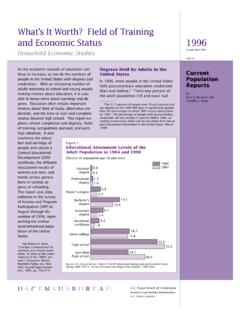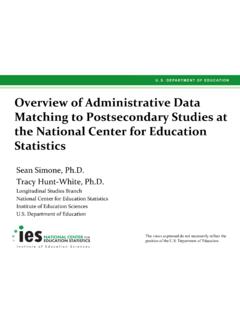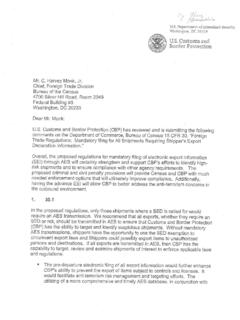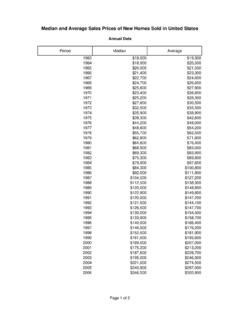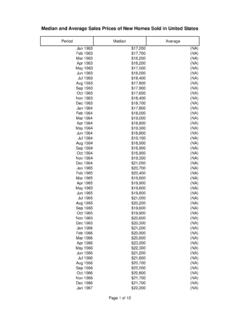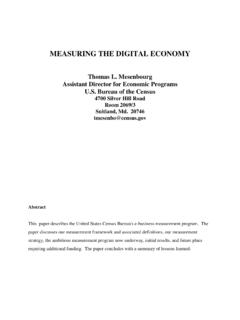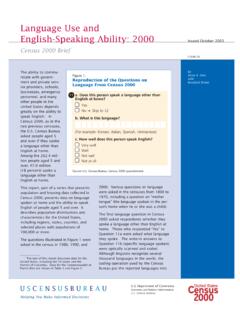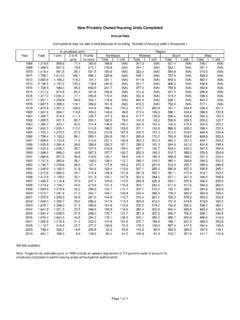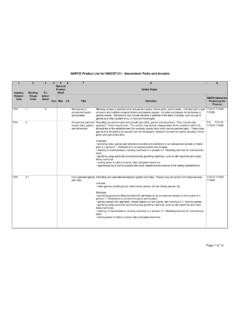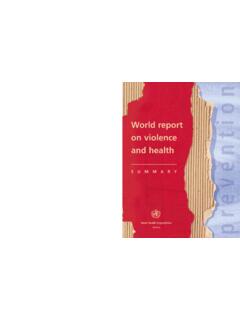Transcription of The Changing Economics and Demographics of Young …
1 The Changing Economics and Demographics of Young Adulthood: 1975 2016 Population CharacteristicsBy Jonathan VespaCurrent Population ReportsP20-579 Issued April 2017 INTRODUCTIONWhat does it mean to be a Young adult? In prior gen-erations, Young adults were expected to have finished school, found a job, and set up their own household during their 20s most often with their spouse and with a child soon to follow. Today s Young adults take longer to experience these milestones. What was once ubiquitous during their 20s is now not commonplace until their 30s. Some demographers believe the delays represent a new period of the life course between child-hood and adulthood, a period of emerging adulthood when Young people experience traditional events at dif-ferent times and in a different order than their parents What is clear is that today s Young adults look different from prior generations in almost every regard: how much education they have, their work experi-ences, when they start a family, and even who they live with while growing up.
2 It comes as no surprise that when parents recall stories of their youth, they are remembering how different their experiences report looks at changes in Young adulthood over the last 40 years. It focuses on how the experiences of today s Young adults differ, in timing and degree, from what Young adults experienced in the 1970s how 1 F. Furstenberg, Jr., On a New Schedule: Transitions to Adulthood and Family Change, The Future of Children, Vol. 20, 2010, pp. 67 87. See also, F. Furstenberg, Jr., et al., Growing Up Is Harder To Do, Contexts, Vol. 3, 2004, pp. 33 41, and J. Arnett, Emerging Adulthood: The Winding Road From the Late Teens Through the Twenties, Oxford University Press, New York, 2014. much longer they wait to start a family, how many have gone to college, and who are able to live independently of their parents. This report looks at a snapshot of the Young adult population, defined here as 18 to 34 years old, and focuses on two periods: 1975 and today (using data covering 2012 to 2016 to reflect the con-temporary period).
3 Many of the milestones of Young adulthood are reflected in the living arrangements of Young people: when they move out of their parents home and when they form families. Because these mile-stones are tied to Young adults economic security, the report also focuses on how education and work experi-ence vary across Young adult living Most of today s Americans believe that educational and economic accomplishments are extremely important milestones of adulthood. In contrast, marriage and parenthood rank low: over half of Americans believe that marrying and having children are not very important in order to become an adult. Young people are delaying marriage, but most still eventually tie the knot. In the 1970s, 8 in 10 people married by the time they turned 30. Today, not until the age of 45 have 8 in 10 people married. More Young people today live in their parents home than in any other arrangement: 1 in 3 Young 2 Census Bureaupeople, or about 24 million 18- to 34-year-olds, lived in their parents home in 2015.
4 In 2005, the majority of Young adults lived independently in their own household, which was the predominant living arrange-ment in 35 states. A decade later, by 2015, the number of states where the majority of Young people lived indepen-dently fell to just six. More Young men are falling to the bottom of the income ladder. In 1975, only 25 percent of men, aged 25 to 34, had incomes of less than $30,000 per year. By 2016, that share rose to 41 per-cent of Young men. (Incomes for both years are in 2015 dollars.) Between 1975 and 2016, the share of Young women who were homemakers fell from 43 percent to 14 percent of all women aged 25 to 34. Of Young people living in their parents home, 1 in 4 are idle, that is they neither go to school nor work. This figure repre-sents about million 25- to 34-year-olds. About the DataThis report uses two surveys from the Census Bureau to look at the demographic and economic characteristics of Young adults: the American Community Survey (ACS) and the Current Population Survey (CPS).
5 It uses a third data source, the General Social Survey (GSS), to look at beliefs, attitudes, and values that Americans have about ACS provides statistics on the country s people, housing, and economy at various geographic levels, including the nation, states, and counties. It uses a series of monthly samples to produce annually updated estimates for small geographic areas. In 2015, the ACS sampled about million households. This report uses 2005 and 2015 ACS data to look at state-level changes in Young adult living arrangements. For more information about the survey, see < /programs-surveys/acs/>. For more information about sample design and methodology, see < /programs-surveys/acs/technical- >.The CPS collects information about the economic and employment characteristics of the civilian, noninstitutionalized population. This report uses the survey s 1975 and 2016 Annual Social and Economic Supplement, which has data on marriage and family, employment pat-terns, work hours, earnings, and occupation.
6 It also uses the 1976 and 2014 June supplement to the survey, which collects data on women s fertility. The CPS counts college students living in dormitories as if they were living in their parents home. As a result, the number of Young adults residing in their parents home is higher than it would be otherwise, especially for 18- to 24-year-olds, who are more likely to be living in college housing. For more information about the CPS, see < >.Since 1972, the GSS has collected data on Americans opinions and attitudes about a variety of topics. Because of its long-running collec-tion, researchers can use the survey to study changes in Americans attitudes and beliefs. The survey is administered by the National Opinion Research Center at the University of Chicago, with support from the National Science The module on the milestones of adulthood comes from the 2012 GSS, the most recent year available, and was developed by the MacArthur Foundation Research Network on Transitions to T.
7 Smith, P. Marsden, M. Hout, and J. Kim, General Social Surveys 1972 2012, sponsored by the National Science Foundation (NORC ed.), Chicago: National Opinion Research Center, Storrs, CT: The Roper Center for Public Opinion Research, University of Connecticut, Census Bureau 3 WHAT DOES IT MEAN TO BE AN ADULT TODAY?Americans Rank Educational and Economic Accomplishments as the Most Important Milestones of AdulthoodTo say that Young adults delay marriage and put off having chil-dren describes behaviors that are reflected in demographic trends for the population as a whole. To put these experiences in context, though, it helps to look at what adults think about them. Do people believe that waiting later to marry or have children is a normal part of adulthood today?The 2012 General Social Survey asked Americans aged 18 and older about how important a variety of experiences are to becoming an adult. Over half of Americans say that getting married or hav-ing children are not important to becoming an adult, and only a third think they are somewhat important (Figure 1).
8 These trends align with research showing that less than 10 percent of men and women think that people need to have children to be very happy in , the highest ranked mile-stones are educational and eco-nomic. Finishing school ranks the highest, with more than 60 percent 2 J. Daugherty and C. Copen, Trends in Attitudes About Marriage, Childbearing, and Sexual Behavior: United States, 2002, 2006 2010, and 2011 2013, National Health Statistics Reports, No. 92, National Center for Health Statistics, Hyattsville, MD, people saying that doing so is extremely important to becoming an adult. The emphasis on educa-tion underlies the rising student debt that many Young people carry. In 2013, 41 percent of Young families had student debt, up from 17 percent in Not only do more Young families have student debt, they are deeper in debt too. The amount owed on student loans nearly tripled, rising from a median of $6,000 to $17,300 across the same period (in 2013 dollars).4 Economic security ranks second in the transition to adulthood.
9 About half of adults believe that having a full-time job and being able to financially support a family are extremely important to becoming an adult (Figure 1). Despite the prominence given to economic security, only a quarter of Americans think that moving out of the parents home is a very important part of adulthood. Given the attention paid to the boomerang generation that has failed to launch, it is surprising that Americans do not rate living independently as a more important step toward Yet in a study by the Pew Research Center, most parents with coresidential adult children are just as satisfied with their living arrangements as parents whose adult children live elsewhere. Similarly, more than 2 in 3 Young adults who live at home are very happy with their family Young families are those headed by someone under the age of 35. Survey of Consumer Finance, Table 13: Family Holdings of Debt, by Selected Characteristics of Families and Type of Debt, 1989 2013 Surveys, Board of Governors of the Federal Reserve System, Washington, DC, K.
10 Parker, The Boomerang Generation, Pew Social and Demographic Trends Report, Pew Research Center, Washington, DC, Young AdultsYoung Adults. This report looks at the population of 18- to 34-year-olds at two time periods, in 1975 and today, covering the years 2012 to 2016. For some parts of the analysis, this report looks at a subsection of this population, the group of 25- to 34-year-olds. Throughout this report, the terms Young adult and Young people are used interchange-ably to refer to these age and cohorts. The population of 18- to 34-year-olds is a cohort, which is a group of people that share a common demographic experience or characteristic (in this case, age). By comparing cohorts at two different time periods, researchers can study how the experiences of a group of people have collectively changed over time. The cohort of 18- to 34-year-olds in 2016 includes people born between 1982 and 1998, which roughly corresponds to the millennial generation. There is no official start and end date for when millennials were born.
